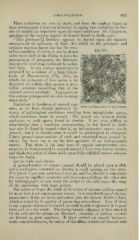Page 593 - My FlipBook
P. 593
AMELIFICATION. : 603
These variations are seen in shells, and from the analogy fonnd in
their development I have no hesitancy in saying that variations in den-
sity of enamel are dependent npon the same conditions. Dr. Carpenter,
speaking of the varying degrees of density fonnd in shells, says
" This [increased] hardness appears to depend upon the mineral
for, whilst in the prismatic and
arrangement of carbonate of lime ;
ordinary nacreous layers this has the crys-
talline condition of calcite, it can be shown Fi0. 3:J7.
in the hard shell of the Pholas to have the
arrangement of arragonite, the difference
between the two being evidenced by polar-
ized light. A very curious appearance is
presented by a section of a large hinge-
tooth of Myo-arenaria (Fig. 337), on
which the carbonate of lime seems to be
deposited in nodules that possess a crys-
talline structure resembling that of the
mineral termed laavellght. Approaches to
this curious arrangement are seen in many
other shells."
Variations in hardness of enamel may
Section of Hinge-tooth of 3Iyo-arenaria.
arise, as we have already indicated, by
reason of pathological conditions resulting from interglobular spaces,
which sometimes occur in enamel. The points are, without doubt,
analogous to such spaces found in dentine. I am even willing to
acknowledge that a condition corresponding to that found in shells
may also be found in enamel—that is, an interprismatic matrix can be
formed ; but if it should occur, it would be pathological in character.
I have ground many sections of teeth and examined many ground by
others, but have yet to see the first specimen of an interprismatic
matrix. That there is the least trace of organic interprismatic sub-
stance to be demonsti'ated in normal enamel I have veiy serious doubts,
and think the action of dilute acids upon fully-calcified enamel substan-
tiates the doubt.
Let us study such action.
A ground-section of mature enamel should be placed uj on a slide
and a cover-glass cemented on, leaving a small opening on two sides.
If a "l^th of 1 per cent, solution of chromic acid be allowed to run under
the cover by capillary attraction and then removed from the other side
by blotting-paper, we can study the action of the acid upon the stage
of the microscope with high powers.
But before we begin the study of the action of chromic acid on enamel
let us see how it acts upon organic tissues. It is considered one of the best
preservative fluids we have, and enters into the famous Midler's fluid,
which is noted for its quality of preserving nerve-tissue. Now, if there
is any organic substance in enamel, we shall be able to preserve it in good
form and note the result. The interprismatic substance is first attacked
by the acid and the prisms are liberated ; chromate of calcium crystals
are formed in great numbers. If there existed an organic interpris-
matic cement-substance, the action of this dilute solution of chromic acid


